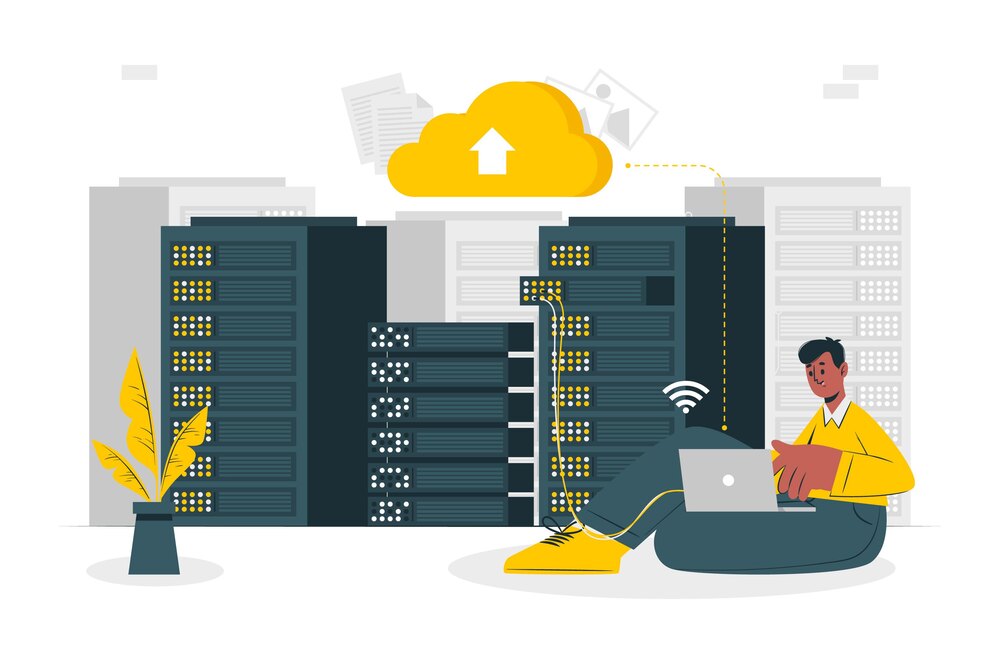
The hybrid cloud merges on-premise systems with cloud services, offering businesses flexibility, scalability, and enhanced efficiency in managing IT infrastructure.
The hybrid cloud is changing how IT works. It mixes on-premise systems with cloud services. Businesses see the need for hybrid clouds. They offer flexibility and can handle more data.
This model makes operations more efficient and data easier to access. It combines the best of public and private clouds. Adopting hybrid cloud strategies is key for modern businesses. It helps align IT with business needs.
Understanding Hybrid Cloud Architecture
Hybrid cloud architecture blends elements from public and private clouds with on-premise systems. This mix allows businesses to use different cloud benefits, ensuring flexibility, security, and scalability.
What is a Hybrid Cloud?
A hybrid cloud mixes on-premises, private, and public cloud services to create a flexible computing environment. This setup allows for easy data and application sharing. Companies keep sensitive data in private clouds and use public clouds for other tasks, which helps them face various operational challenges.
Components of Hybrid Cloud Systems
Key components of hybrid cloud systems include:
- Cloud Storage: Offers scalable and flexible storage solutions, accommodating varying data requirements.
- Compute Resources: Virtualized computing infrastructure allows for resource allocation based on demand, enhancing performance and efficiency.
- Networking Components: Ensures secure and reliable connectivity between the different cloud environments and on-premise resources.
Cloud service models like IaaS, PaaS, and SaaS are also vital. They help form an effective hybrid cloud architecture. These models let businesses integrate their systems with cloud services. This optimizes both operations and the use of resources.
| Cloud Service Model | Description | Hybrid Cloud Benefit |
| IaaS | Virtualized computing resources over the Internet | Flexible resource scaling based on the need |
| PaaS | Platform providing tools for application development | Streamlined development and deployment processes |
| SaaS | Software available via the cloud on a subscription basis | Reduced IT overhead and easier access to applications |
Exploring the Benefits of Hybrid Cloud
The hybrid cloud model offers big benefits for today’s businesses. It combines on-site infrastructure with cloud resources. This mix brings cost savings, flexibility, better performance, and growth possibilities. Companies can create customized solutions, tackling unique challenges while using resources wisely.
Cost Efficiency and Flexibility
A top advantage of hybrid cloud is saving money. Companies can pay for what they use, cutting down on upfront costs. This setup boosts flexibility, letting businesses balance their spending between on-site and cloud services as needed. Keeping sensitive data on-site and using the cloud for other tasks helps in better financial control.
Performance Optimization and Scalability
Hybrid cloud setups enhance performance by smart workload management. They let businesses move resources between on-site and cloud as demand changes. Being able to scale quickly is another plus, readying companies for busy times without huge hardware investments. This ensures reliable services and peak performance in all areas.
Key Features of Hybrid Cloud Solutions
Hybrid cloud solutions give businesses more flexibility and growth options. They combine cloud computing and on-premise infrastructure well. This mix lets companies integrate their systems efficiently. It creates a connected business environment that’s key to success.
Cloud Connectivity and Integration
Good cloud connectivity lets data move easily between local and cloud systems. This is vital for firms using both types of infrastructure. It helps them operate smoothly. Important parts of cloud connectivity include:
- APIs that make different software talk to each other;
- Middleware solutions that help different systems communicate;
- Cloud management platforms for better control in a hybrid setting;
- Secure gateways that keep data safe when moving between systems.
Cloud integration is essential for teamwork within businesses. It ensures data can always be reached and used, no matter where it is stored. Key features for a good cloud integration are:
- Keeping data consistent everywhere, for accuracy;
- Syncing data in real-time, for up-to-date access;
- Scalable integration that grows with the business;
- Strong security to protect data during integration.
| Feature | Description | Benefits |
| APIs | Enable data sharing between apps. | Makes operations more efficient. |
| Middleware | Connects different systems. | Makes integration simpler. |
| Cloud Management Platforms | Manages hybrid resources. | Improves control and optimization. |
| Secure Gateways | Keeps data safe during transfers. | Enhances security. |
Using these features, hybrid cloud solutions boost business operations. They help firms stay ahead in the fast-changing digital world.
Hybrid Cloud vs. Multi-Cloud Architecture
Understanding hybrid and multi-cloud architectures is key for companies optimizing their cloud setups. A hybrid cloud merges on-site resources with cloud services for a flexible setup. It allows for easy data and app sharing between local and cloud platforms.
On the other hand, multi-cloud architecture uses services from many cloud providers without linking them. This strategy keeps companies from being tied to one provider and lets them pick services that fit their needs best. Yet, it might make managing resources harder, as each cloud service has its system.
Here is a comparison of the two models based on key factors:
| Factor | Hybrid Cloud | Multi-Cloud Architecture |
| Integration of Resources | Combines on-premise and cloud resources | Uses multiple cloud services independently |
| Management Complexity | Generally lower; lower-integrated management systems | Potentially higher; multiple platforms to manage |
| Data Security | Enhanced control over sensitive data | Varied security measures; depend on the providers |
| Service Diversification | Leverages features of both on-premise and cloud | Access to a wide array of services from different providers |
| Scalability | Flexible scaling options, mixing resources | Scaling depends on individual cloud services |
Choosing between hybrid cloud and multi-cloud depends on a company’s needs in data security, simple management, and flexibility. Both offer unique benefits. With careful planning, they align well with business aims.
Cloud Interoperability in Hybrid Models
Cloud interoperability is crucial in hybrid models. It lets different systems talk to each other effectively. This smooth communication between on-premises and various cloud setups boosts efficiency and innovation. The success in achieving interoperability lies in selecting the right technology and following established protocols.

Ensuring Seamless Data Exchange
Hybrid cloud environments need smooth data sharing. This gives real-time information access across different systems, ensuring data is uniform and reachable, no matter its location.
- Utilizing standardized data formats for compatibility.
- Implementing synchronization mechanisms to keep data updated in all environments.
- Employing robust data integration tools that support various cloud and on-premises solutions.
Protocols and Standards for Interoperability
Protocols and standards are vital for cloud interoperability. Standards like REST and SOAP help disparate systems communicate well. These protocols let various apps share data and functions without hassle. Choosing which protocol to use depends on the need, but some are key:
| Protocol | Use Case | Advantages |
| REST | Web services and APIs | Simplicity and scalability |
| SOAP | Enterprise-level applications | Security and transaction compliance |
| GraphQL | Data querying | Efficiency in data retrieval |
Choosing the right protocols helps businesses maximize cloud interoperability in hybrid models. A solid plan for data exchange and following the right protocols boost cloud strategies. It ensures smooth operations across many platforms.
Strategies for Cloud Migration to Hybrid Environments
Migrating to hybrid environments requires careful planning and the right tools. You must make sure the transition to a hybrid cloud is smooth. It’s also key to assess workloads well and pick the right data to move.
Here are some top strategies for a good cloud migration.
Planning Your Cloud Migration
Creating a good migration plan is vital. A strong plan should have these points:
- Assessment of Existing Workloads: Look at your current apps and data to see what needs moving.
- Data Selection: Pick important data that will do well in hybrid settings.
- Establishing a Timeline: Make a realistic schedule for each step of the move.
- Risk Mitigation Strategies: Find potential risks and plan how to handle them.
Tools and Services for Hybrid Migration
There are many tools to help move to hybrid environments more easily. These tools make the process smoother and help manage things better:
- Cloud Management Platforms: These allow you to control several cloud services with ease.
- Third-Party Migration Tools: Specialized tools make moving data and integrating systems simpler.
- Automation Solutions: Using automation can reduce the need for manual work and speed things up.
Check out this table for some top tools and what they offer for cloud migration:
| Migration Tool | Key Features | Benefits |
| AWS Migration Hub | Centralized tracking, integration with AWS services | Improved visibility, ease of management |
| CloudEndure Migration | Continuous replication, minimal downtime | Quick recovery, efficient resource usage |
| VMware HCX | Seamless VM migration, hybrid cloud integration | Reduced complexity, enhanced flexibility |
Cloud Bursting and Workload Distribution
Cloud bursting is key in hybrid cloud plans. It helps businesses manage sudden workload increases efficiently. This method lets firms move data and applications to the cloud when demand goes up. It helps keep things running smoothly.
This flexibility means organizations only pay for extra cloud resources when needed. This leads to cost savings and better use of resources.
Workload distribution is very important. It helps balance tasks between on-premise and cloud setups. This makes sure performance stays high without overloading any system.
It leads to smarter resource use and makes IT operations more effective.
| Feature | On-Premise Infrastructure | Cloud Resources |
| Cost | Fixed costs, ongoing maintenance | Pay-as-you-go model, no maintenance |
| Capacity | Limited by physical hardware | Flexible, virtually unlimited |
| Scalability | Difficult and time-consuming | Instant scaling, responsive to demand |
| Performance | Consistent, but may face overload | Dynamic resource allocation during peak times |
Using cloud bursting in a hybrid cloud setup lets firms adjust quickly to changes. It makes workload management better. This boosts how well operations run and meets customer needs anytime.
Cloud Orchestration and Management Techniques
Cloud orchestration is key in the evolving world of hybrid cloud environments. It helps smooth operations and boost productivity. Strong management methods are critical to automating cloud resources well. This reduces the need for manual work and improves how things run.

Automating Cloud Resources
Cloud automation is crucial in today’s business plans. It takes over routine tasks, allowing organizations to focus on bigger goals. This cuts down on mistakes and boosts efficiency. Teams can then use their resources in smarter ways. Benefits of cloud automation include:
- Faster deployment of cloud services.
- Consistent handling of resources.
- Quick adjustments to new business needs.
Monitoring and Optimization Tools
Good monitoring tools are key for monitoring how resources are used and performed. These tools help businesses understand their cloud setup better and spot problems early. With continuous checks, firms can make choices based on solid data. This improves their hybrid cloud approach. The value of these tools includes:
- Tracking how things run in real-time.
- Getting warnings about possible problems.
- Adjusting resources to match how much they’re used.
| Tool Type | Purpose | Key Features |
| Cloud Automation | Streamline resource deployment | Automated workflows, scalability, cost management |
| Monitoring Tools | Performance insights | Real-time analytics, alerting systems, utilization reports |
| Optimization Tools | Resource efficiency | Predictive analytics, resource rightsizing, budget tracking |
Using these cloud orchestration strategies with good management improves how well things run. It also makes organizations more flexible.
The hybrid cloud has become a crucial strategy for enhancing flexibility and efficiency in IT management. Blending on-premise systems with cloud services, allows organizations to optimize operations while leveraging their existing infrastructure. Key benefits include cost savings, improved performance, and seamless scalability, making hybrid clouds essential in today’s rapidly evolving tech landscape.
As businesses increasingly shift towards hybrid cloud setups, they can achieve better system integration and implement more robust cloud strategies to meet changing demands. By combining public and private cloud resources, companies gain a balanced, adaptable solution for managing their computing needs.
For businesses planning their cloud journey, embracing hybrid cloud models is vital. This approach enhances resilience and innovation, enabling companies to thrive in an environment where adaptability is crucial for success.
Ready to innovate and transform your business? Say hello to CodeBeavers!
If you are looking for ways to bring your product or app ideas to life? We’ve got your back. CodeBeavers has the tools and engineers you need to make your projects come alive. With CodeBeavers, you’ll be able to build faster than ever, deploy code with ease, and scale like never before. Send us your requirements now, and let’s start winning together.




